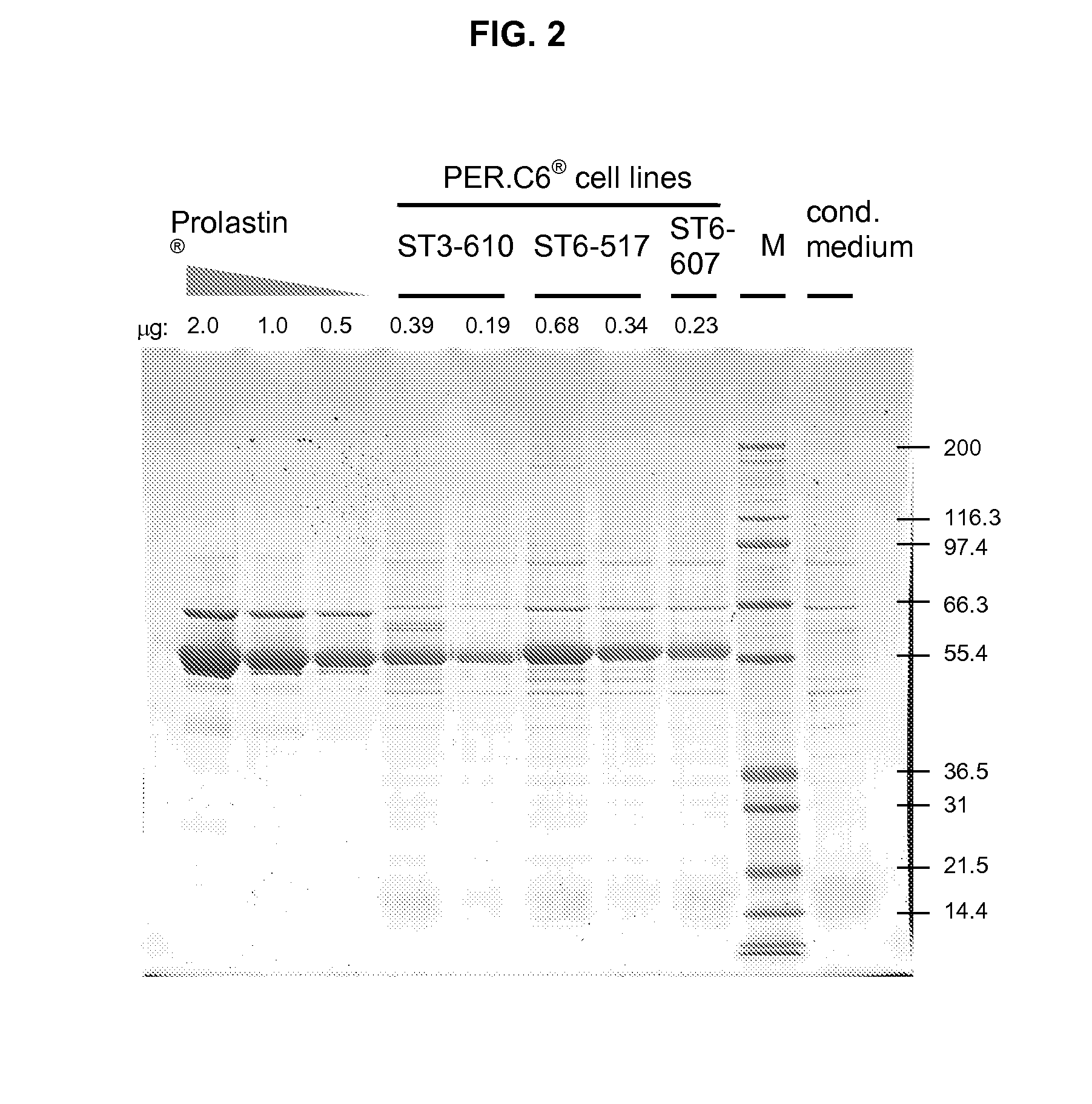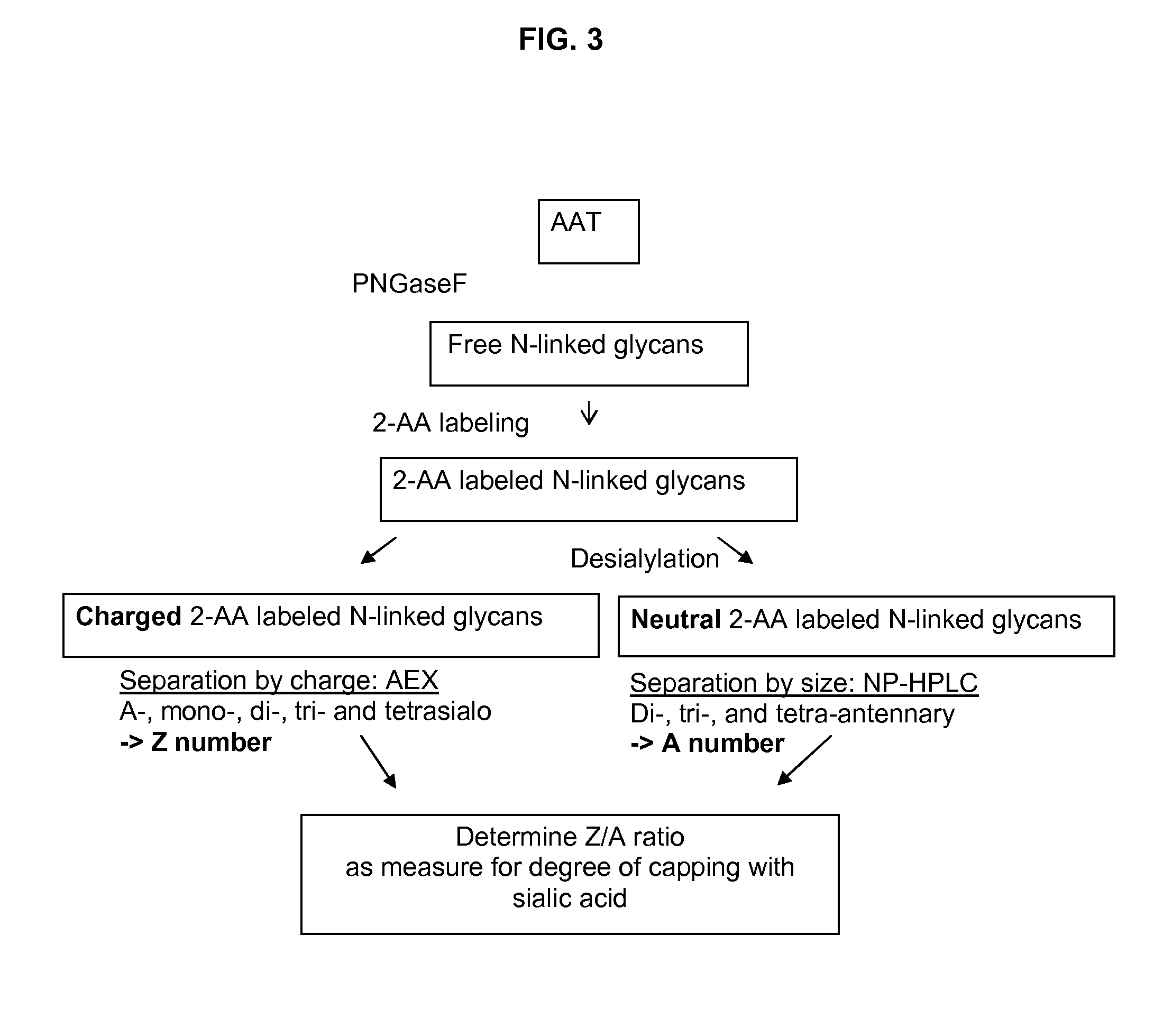Recombinant human alpha1- antitrypsin
a technology of aat and aat, applied in the field of recombinant human alpha1-antitrypsin, can solve the problems of limited plasma material availability, low or zero plasma level of aat, and risk factor for the development of emphysema, and achieve the effect of suitable pharmacokinetic profil
- Summary
- Abstract
- Description
- Claims
- Application Information
AI Technical Summary
Benefits of technology
Problems solved by technology
Method used
Image
Examples
example 1
Cell Line Generation and Specific Productivities
[0057]Seven hundred PER.C6® cell lines expressing human AAT and co-expressing either an α-2,6-sialyltransferase (SIAT1; NM—003032) or an α-2,3-sialyltransferase (SIAT4C; L23767) (PER.C6-AAT-ST3 / PER.C6-AAT.ST6) were generated under serum-free conditions, as described in WO 2006 / 070011. Forty-seven serum-free PER.C6® cell lines producing either AAT-ST3 (27 cell lines) or AAT-ST6 (20 cell lines) were selected based on highest yield as determined by ELISA (AAT Elisa Kit, US Biologicals) from independent cell line generation programs using nucleofection as transfection tool. The expression plasmid contained the coding sequence for human AAT (SEQ ID NO:2) and the coding sequence for human ST3GalIV, both driven by a cytomegalovirus promoter that has been modified to achieve high levels of gene expression in PER.C6® cells (Yallop et al., 2005). The plasmid maps of the AAT expression vectors (pAATopt-ST3 and pAATopt-ST6) are shown in FIG. 9.
[00...
example 2
Biochemical Analysis
[0059]Integrity of PER.C6-rAAT
[0060]The supernatants of the 47-batch cultures were analyzed on SDS-PAGE stained with colloidal blue. Cell culture harvest of the PER.C6-rAAT (non-purified) samples showed AAT as the main protein band on SDS-PAGE. Furthermore, the gels showed intact AAT bands (shown in FIG. 2) indicating the integrity of the material.
[0061]Activity of PER.C6-rAAT
[0062]Initially (in lieu of a chromogenic activity assay), an indication for activity was determined by analyzing the formation of a complex of PER.C6-rAAT with human neutrophil elastase. To this end, cell culture harvests of PER.C6-rAAT samples were incubated with 0, 0.1, 0.2 and 0.4 μg elastase for 30 minutes at 37° C. and subsequently applied on a 4-12% BIS-Tris SDS-PAGE and stained with colloidal blue. All PER.C6-rAAT samples tested formed a complex with elastase (data not shown), indicating activity of the preparations. Further activity testing was done with a chromogenic assay based on...
example 3
Pharmacokinetics of PER.C6-rAAT in a Rat Model
[0073]A rat model was established to determine the pharmacokinetics (PK) of PER.C6-rAAT. The model should be able to detect AAT present in unpurified PER.C6-conditioned medium (CM) at concentrations of about 40-100 μg / mL (at 2 mL / kg resulting in doses of about 80-200 mg / kg).
[0074]Four experiments were performed: the first two to set up the model and the second, third and fourth experiments to select the PER.C6-rAAT cell lines producing rAAT with the most optimal PK characteristics. In these studies, human pdAAT (PROLASTIN®) was used to establish the model and as reference. The experimental procedure was as follows: rats (male Wistar, age 8 weeks) were dosed i.v. in the tail vein with the AAT test samples (dose volume 2 ml / kg, dose range 50-200 μg / kg, n=3 rats per group). Blood was sampled from the tail tip pre-dose and at various time points following dose administration. The blood was collected in K2EDTA microvettes and plasma was prepa...
PUM
| Property | Measurement | Unit |
|---|---|---|
| Fraction | aaaaa | aaaaa |
| Fraction | aaaaa | aaaaa |
| Fraction | aaaaa | aaaaa |
Abstract
Description
Claims
Application Information
 Login to View More
Login to View More - R&D
- Intellectual Property
- Life Sciences
- Materials
- Tech Scout
- Unparalleled Data Quality
- Higher Quality Content
- 60% Fewer Hallucinations
Browse by: Latest US Patents, China's latest patents, Technical Efficacy Thesaurus, Application Domain, Technology Topic, Popular Technical Reports.
© 2025 PatSnap. All rights reserved.Legal|Privacy policy|Modern Slavery Act Transparency Statement|Sitemap|About US| Contact US: help@patsnap.com



